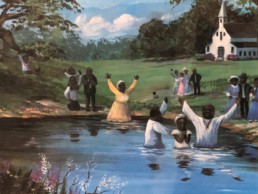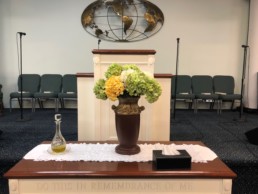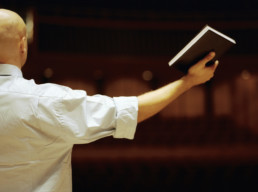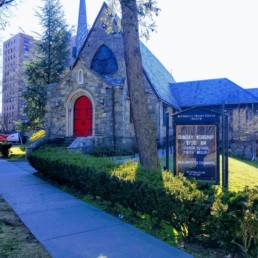Job and the Super Bowl
Job and the Super Bowl
Zoé Chevalier | zc2504@columbia.edu

Fewer congregants come to Bible study on Wednesdays than on Sundays at the United Pentecostal Church in Harlem. But it is no less spirited. On a recent Wednesday, seven worshippers sit in the prayer room in front of Pastor Michael Granttan. Despite his whitening hair, Grattan is an energetic man, often jumping to his feet to illustrate a lesson. He is dressed in casual clothes: A knitted sweater and pants have replaced the suit of Sunday’s service.
Grattan’s teaching style is a combination of Bible verse study, personal anecdotes, sports references and modern-day cultural applications. During the first part of the lesson, people in the audience are encouraged to ask all the questions they want, both Biblical and personal.
A young woman, whom I recognize as one of the singers of Sunday’s service, starts off by asking, “How do we know if the hardship we have been given comes from God?”
She proceeds to tell the tale of a family member who had been diagnosed with breast cancer and refused treatment, waiting for God to cure her. One day, she went to a naturopathic doctor who gave her an ointment to put on her breast. This, she said, led to an emergency mastectomy. The woman found out that during the year and a half that she had not been given treatment, the tumor had not metastasized. She praised God for protecting her. Her husband, however, blamed her for losing faith and getting the surgery, saying that God was not done curing her.
Hearing this story, Grattan stands, raises his arms and starts preaching the story of Job from the Book of Job, which is part of the Old Testament.
“Job’s animals were kidnapped!
The house fell over his children!
And then he got sick! And we know there is nothing more personal than disease. There was puss coming out of his body, it was truly horrible, but he never stopped praising the Lord.”
Grattan then uses one of his favorite sports allegories to illustrate his message: “Job was hit so hard, like in a boxing ring, poom the boxer, he got a hit with a right fist then a left fist, then he got a full-body blow!” Mimicking the scene he throws his fists in the air, punching an invisible Job.
Soon, he sits back down, saying, “We know that God gave him those hardships, but generally speaking, there are no parameters that define whether or not a hardship comes from God, we create a lot of our own problems, but we need to continue to praise God no matter what.”
He adds that he believes in going to the doctor, because “God can cure you anywhere, on the operating table as well as in your kitchen, so let him cure you though your doctor.” With a deep sigh, he concludes: “I understand, as you know sister Grattan died recently.” The crowd goes silent. Everyone knows about the recent death of the pastor’s wife to cancer.
During the second half of the session, Grattan doesn’t shy away from getting into contemporary pop-culture discussions. He comments on the Superbowl half-time show, featuring Shakira and Jenifer Lopez, saying, “I don’t understand all the fuss about the fact that it was not family-friendly.” When someone brings up that Jennifer Lopez might have been mocking the sign of cross, he defends her. “No! She was simply pole dancing!”
Grattan often tries to tone down more conservative branches of the church. “I believe in balance. God is not stupid, only human beings are. Be careful about turning principles into law.” When someone in the church asks if women are allowed to wear pants, he says of course. “And what about swimsuits?” asks a man. “Is it true we are not allowed to go to the beach or swimming pool even on a hot day?” Another woman laughs. “I go to the beach!” she says. Grattan ends the discussion saying, “Yes you can. I also believe that there are apostolic swimsuits that are more modest.”
At the end of the study session, Grattan gets more serious, and passes around a sheet of paper: “A brief look at the errors of the doctrine of the Trinity.” The document is filled with typos as the pastor has “whipped it out” quickly this afternoon. Once again, Grattan stands up, agitated.
“99 out of a 100 times, 999 out of 1000 times..”
His voice grows louder.
“9999 out of 10000, and I could keep going… people turn to Genesis 1:26 to justify that God is plural.”
Genesis 1:26 is part of the Old Testament and says: Then God said, “Let us make mankind in our image, in our likeness, so that they may rule over the fish in the sea and the birds in the sky, over the livestock and all the wild animals,[a] and over all the creatures that move along the ground.”
Everyone pulls out their phones to look up the verse, and the pastor continues. “Scholars understand that this is not what this verse means, the clergy understands, but no one is teaching laypeople!” According to the Pentecostal Church, God, Jesus and the Holy Spirit are all part of the same entity, not separate beings. He sits back down: “Do you understand?”
A woman in the back raises her hand shyly. “I think that it will make sense once I really go through the scripture,” she says.
“Yes, you need to keep asking questions and work hard, I can’t give you understanding,” Grattan concludes. As the clock strikes 9 p.m., all rise and pray together.
The Holy Spirit
The Holy Spirit
Zoé Chevalier | zc2504@columbia.edu
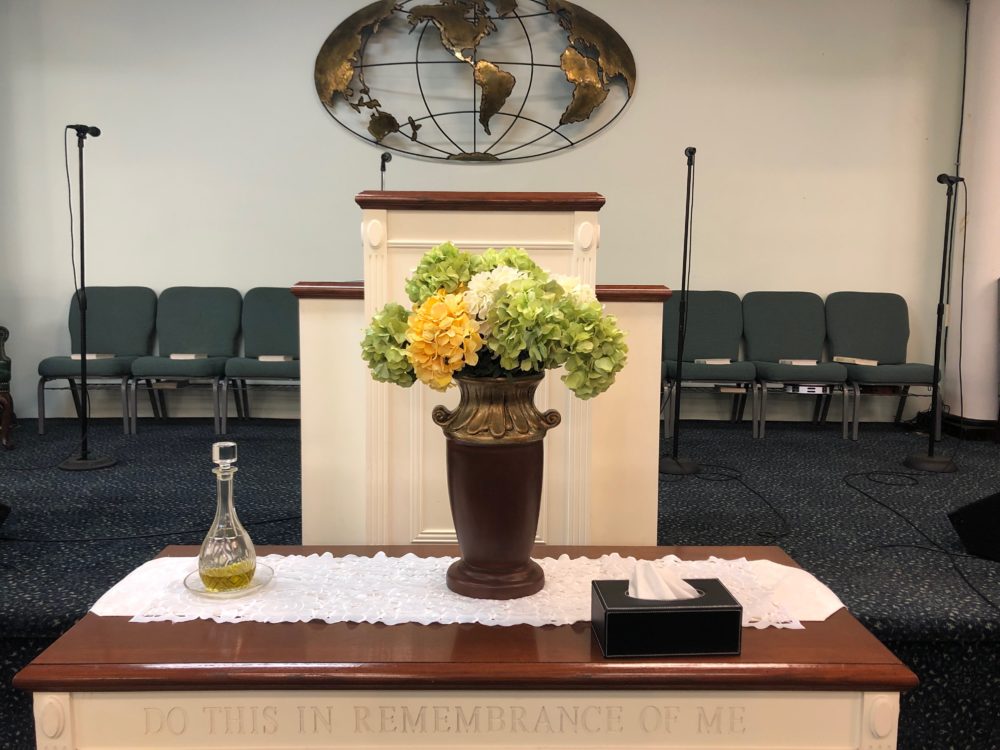
The congregation slowly gathers inside the prayer hall at the United Pentecostal Church on 125th Street, between Broadway and Amsterdam. Sunday school ran a little late, but that’s ok, there are no formal hours here. The prayer service will last for about two and a half hours, but none of it will be passive: Worshippers will stand, move, dance, and sing.
Rows of chairs face a stage, where microphones and instruments—an electric piano, drums and a tambourine—signal the singing to come. No crosses, stain-glass windows or icons of saints can be seen here. Although Pentecostals believe in Christ, the traditional crucifix found in Catholic churches is replaced with a large statue representing the earth and a collection of flags from different countries. In front of the pastors console is a wide communion table, covered by a white veil. “It’s to make it look religious,” says Pastor Michael Grattan.
Patrice Martin has come all the way by bus from Philadelphia to be here today. Grattan witnessed to her 40 years ago, when she was a college student. “He saved me,” says Martin. But she feels directionless, and came to the Church to reconnect with the one who once helped her. Martin does not want to bother him, and so she sits in a corner. When the pastor comes to say hi, she introduces herself as Sister Patrice Martin. He thinks about it and says, “That’s strange. I witnessed to a Sister Patrice many years ago.” They fall into each other’s arms.
One of the singers, dressed in all white comes up to the audience, arms opened. “Let’s have a group hug,” she says. Slowly, she walks away into a corner of the room, where worshippers gather. A circle is formed. At first quiet, the circle soon comes to life. The Holy Spirit is about to arrive. Worshippers are moving their hips and raising their hands, opening their mouths wide. The rumble of their feet on the ground creates vibrations, which are growing throughout the church.
A symphony of different languages is spoken all at once: English, French, Spanish and many other languages that I do not recognize. Most of it is unintelligible, with a repetition of “Amen” and “Hallelujah,” creating a rhythm, and growing faster, louder, more passionate.
Another singer is brought into the middle of the circle. Surrounded by her peers, she bangs her chest right above her heart and moves her hands to the rhythm of her words. They are praying for her. Some are smiling, looking up at the heavens, at times letting out a powerful laugh.
Others give out painful moans, bow their heads.
Brother Philippe comes up to me and explains in French. “They are letting the Holy Spirit speak through them. They just open their mouths and let him speak.” Like many people here, Philippe was once a Catholic, but he grew tired of needing intermediaries to speak with God. Pentecostals do not believe in the Virgin Mary as the first interlocutor. “It’s like parents with their children,” explains Philippe. “You do not need to have your mother always intervene on behalf of you to your father, you have to go directly.”
Pentecostals believe in a direct approach to the Lord. No Saints, no Virgin Mary is needed as intermediary. Once a person has been “saved,” the previous “sinner” becomes a saint. All baptized members of the church are saints. They can speak directly to God, and let the Holy Spirit speak through them. They are also called to “witness” to other “sinners,” and transmit the word of the Lord.
This ritual is rooted in the day of the Pentecost, a passage in the Bible’s Book of Acts, the fifth book in the New Testament. According to Acts 2:4, the Holy Spirit descended upon Jesus’ apostles, baptizing them in the Holy Spirit, “and there appeared unto them cloven tongues like as of fire, and it sat upon each of them. And they were all filled with the Holy Ghost, and began to speak with other tongues, as the Spirit gave them utterance.” Pentecostals believe in a literal interpretation of the Bible, and see speaking in tongues as an act that can happen at any time, to anyone who has been saved.
This speaking in tongues continues throughout the service. Sometimes, as Grattan is preaching, someone will start laughing uncontrollably, someone else will speak in a different language. Once some people started making snake-like noises in the back of the room, the hissing sounds growing louder. When the Holy Spirit wants to speak, you let him in. As the service progressed, Grattan’s sermon grows more passionate:
“Don’t waste your alone time and your suffering, praise the Lord and nothing should offend you. If you can’t run, walk, and if you can’t walk, roll, but keep following God. We are the chosen people, the Second Testament says so! We are like the Jews.”
Suddenly, he stops, and the voices in the crowd go silent. One by one, some worshippers go up in front of the stage and kneel in front of the pastor, waiting to be blessed. A pregnant woman bows with difficulty. Children run up to the stage.
The adults wait patiently as Grattan slowly kneels to their level, holds their head and whispers “In the name of Jesus Christ.” Slowly they go back to their seats, calmer, blessed. Sister Patrice stayed in her seat the whole time, her eyes closed, praying. At times, she called out “Amen, Halleluyah.” A glorious smile was spread across her face.
The Invitation
The Invitation
Kate Cammell | kac2261@columbia.edu

With her right hand placed over her heart and her left palm opened towards the balcony, Angela Lockett-Colas invited everyone in the church to join in the communion service. The stage lights above her shifted from ice blue to light pink and the eight-member praise band began to play a soft rock melody.
Forefront is an interdenominational church with roots in the Evangelical movement. It’s tucked along a Borem-Hill side street at 509 Atlantic Avenue. During a Sunday morning service, Lockett-Colas, Forefront’s creative director, told the congregation, “Communion is something we do because of the gift we have in Jesus Christ.” As the beat picked up tempo, she reminded the nearly 150 gathered people of the ways that Jesus suffered. “You might feel [persecuted] like that too but you’re loved. You’re loved,” she said.
As Lockett-Colas ushered congregants into the ritual, there was a fullness to her tone that felt assuring, like a mother comforting her children. She beamed as she summoned “anyone” to receive God’s love and to affirm their commitment to Him.
People stood below her on either side of the stage with wooden bowls of bread and large mason jars of red wine, symbolizing the body and blood of Christ. In the Protestant expression of Christianity, communion is a ritual where believers dip bread in wine, and as they eat the mixture they’re asked to reflect on Jesus’ sacrifice.
After Lockett-Cola spoke, members were initially slow to take communion. It was early, so people puttered, like the city buses that had ushered some there that morning. In the last row of the chapel, Georgina Orin followed her friend Grace Dowd into the aisle. Orin’s polka dotted dress sashayed on the wooden floor as she moved in time to the music. Orin, a Californian who once lived in New York, attends Forefront whenever she’s in town.
For Orin, communion is about taking a moment to think about herself in relation to the world around her. Despite the music and the whirl of the lights, there’s a stillness that believers talk about inside themselves. “I think communion is a way to remind you to nourish yourself and that you’re a part of something bigger,” she said.
After reaching the front of the line and dipping the bread in wine, Orin and Dowd made their way back down the aisle. Back at their seats, Orin rested her head on Dowd’s shoulder as they listened to the praise band. People around them raised their hands in the air and bounced on their heels, feeling the music and waiting for everyone to partake in the weekly rite.
Just in case anyone missed Lockett-Colas’s invitation, it was underscored by bold white letters on a large screen at the front of the chapel. “Communion,” the sign announced. Below that it read: “All are welcome at God’s table.” And for Forefront’s members who, like Dowd, identify as queer, seeing “all” written onscreen was key. It’s why many choose to take communion here.
Forefront became an LGBTQ-affirming church in 2014, a controversial move for an Evangelical congregation. The choice was met with loss of both members and funding, but the church stood by its choice. It’s website proudly reads, “We seek community that is inclusive of ALL people.”
Though communion is an individual practice, it’s undertaken—as its name implies—as a community. At Forefront that includes “Conventional Christians and questioning skeptics, Believers and agnostics, Women and men, those of all sexual orientations and gender identities, and Those of all classes and abilities.” It’s a church where juxtapositions are encouraged to rub shoulders.
This is reflected in the communion service as well—old tradition meets new meaning, and, for those who partake of it, a fortification with the warmth of red wine and dance on a chilly February morning in New York City.
Hillsong's Carl Lentz Can't Keep God to Himself
Hillsong's Carl Lentz Can't Keep God to Himself
Madeline Simpson | mms2331@columbia.edu
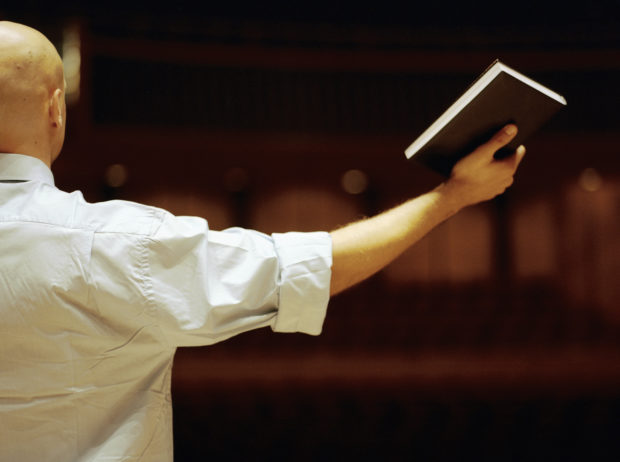
Carl Lentz enters the stage of Hillsong NYC in the middle of a worship song.
In a light-wash denim button-down and black skin-tight jeans, he worships onstage. He stands behind the worship leaders and raises his hands, his body almost convulsing with the rhythm as he dances and sings. He wears a few silver necklaces (one with a cross dangling from it) and a red bracelet.
When the music fades, he breaks through the line of musicians in front of him and shouts with a slight southern twang.
“Come on! God is good! If you believe that, raise your voices!”
The crowd roars in response. He steps back behind the musicians and the music continues.
Lentz is a celebrity pastor. His Instagram page boasts a blue checkmark, a follower count of 642,000, pictures of his son hanging out with Justin Bieber and basketball games with rapper Drake.
Evangelical churches, especially evangelical megachurches, are often focused around a big personality who leads the church, teaching every Sunday. The sermons are typically based on Bible scripture and taught using engaging stories and analogies from the pastor’s own life.
When the music portion of the service comes to a close, Lentz takes center stage. He is alone, except for a musician who plays keys throughout the sermon (a low-level melodic hum) and two security guards who sit on the far right and far left mini-staircases leading to the stage.
Behind Lentz, a massive screen projects the words, “I Can’t Keep It to Myself” in neon blue cursive.
The pastor opens with a question to the thousands in the crowd: What can you not keep to yourself?
“If you know someone who is in love, if you know someone who is vegan, if you know someone who is a parent... they can’t keep it to themselves.”
Lentz launches into a story about his daughter’s dance recital, about how he could not sit quietly in his chair during the recital. About how he stood up and cheered for his daughter throughout the group performance.
Then, he directs the audience to a bible verse on the screen from the book of Philemon.
As he reads, the crowd responds.
“Come on, pastor.”
“Amen.”
“Really good.”
“That’s good, pastor.”
Some clap in response to Lentz. Some stand on their feet and shout encouragement at him.
When he says something moving and few respond, Lentz calls out the crowd.
“Come on, somebody! You can clap. Twenty other people did!”
The message is a tutorial on how to evangelize. Lentz begins by comparing a life with sharing the story of Christ (“impact on others” leading to “deeper revelation”) to a life without (“minimal impact” leading to “hollow religious patterns”). He talks about how his parents were part of the “Jesus People” movement of the 1970s, about how their goal was to simply share the Good News about the Lord whenever they could.
The sermon is the third that Lentz preached that day—the church holds two-morning services (9:00 a.m. and 12:30 p.m.) and one evening service (5:00 p.m.). His voice is scratchy and becomes scratchier throughout the sermon. Every word is an inspirational shout. He moves around the stage as he preaches, waving his microphone-holding hand so much that his voice fades in and out of pick-up range.
The ultimate teaching point comes when Lentz tells the crowd that their own stories are all they need to share the Gospel.
“The part of your story that you think disqualifies you qualifies you more than anything else… You have to find your rhythm. Find the way you’re going to use your platform.”
The service was set to end at 6:30 p.m., but at 6:50 p.m., they’re still in the midst of song. By the time Lentz closes his sermon in prayer, his face glistens with sweat.
Over the music, which again fills the theatre, he asks the crowd to bow their heads and calls out to anyone who wants to become a Christian—an altar call.
“Raise your hand if you want to know the Lord tonight. That’s right, raise those hands.”
He leads the hand-raisers through the prayer that Christians believe welcomes you into the house of the Lord, thus guaranteeing an eternity in Heaven. A verse from the biblical book of Romans is displayed on the screen: “If you confess with your mouth, ‘Jesus is Lord,’ and believe in your heart that God raised him from the dead, you will be saved.”
The audience breaks into raucous cheers, welcoming their new brothers and sisters into the family of God.
Lentz disappears behind the row of musicians, who close the night.
Ringing of the Bells
Ringing of the Bells
Kelly Davis | kwd2111@columbia.edu
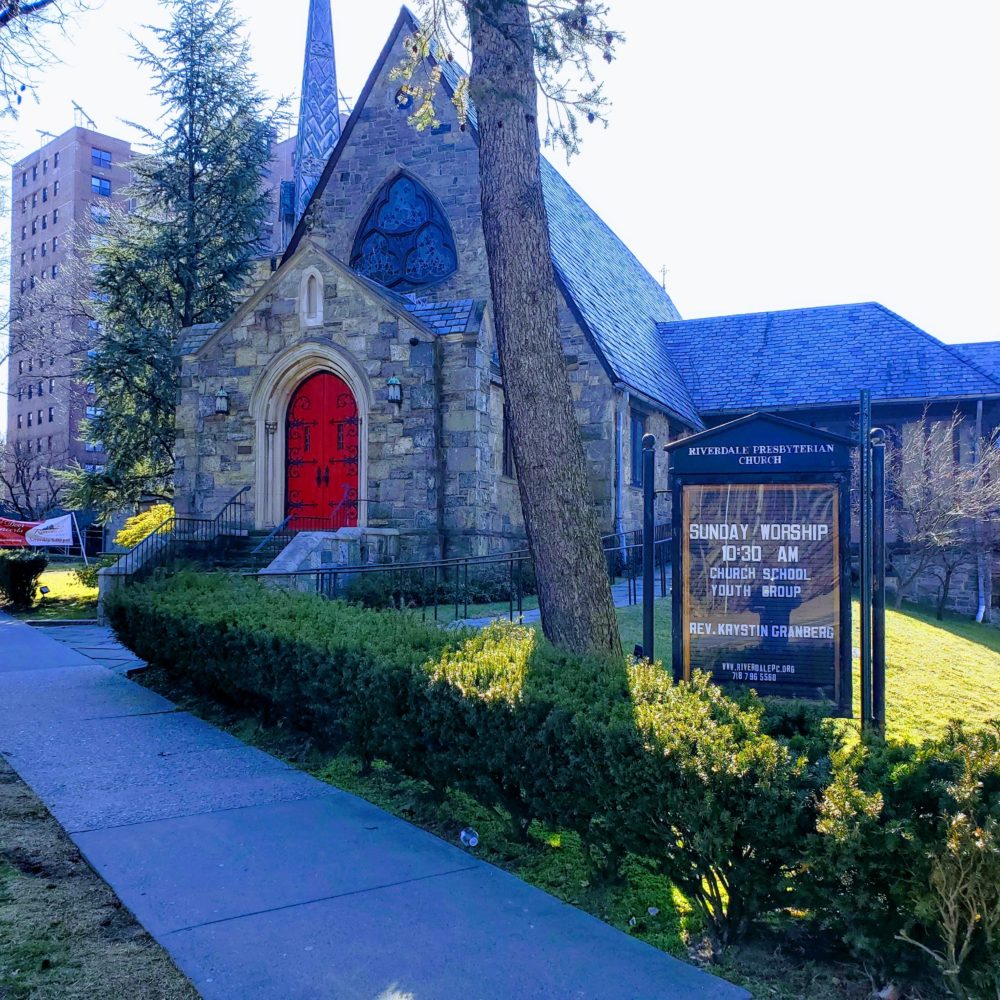
Just minutes before the Sunday morning service, Riverdale Presbyterian Church in the Bronx feels more like a mini social hour than a sanctuary. The gothic-inspired structure under a great dome is readying itself for the sermon.
On the right side of a vast altar sit dozen choir members, men and women, in long red gowns with white trimmings around their necks.
Riverdale Presbyterian, located at 4765 Henry Hudson Parkway, is a church diverse in both age and culture. On this Sunday morning, Blacks and Whites, Asians and Hispanics chat together in wooden pews that form a semi-circle around the great altar. A large loaf of bread and a goblet of wine are placed intentionally at the center of the altar, ready to be broken and eaten as a memorial to the body of Christ.
Between gaps of empty pews, huddles of three or four congregants, mostly women, whisper and chuckle quietly, with familiarity of old friends catching up.
“They better ring these bells soon,” a middle-aged woman mumbles under her breath to the man sitting next to her. “It is already 10:33 a.m.”
Churchgoers continue to speak amongst themselves for a few more minutes until a distinct, piercing sound fills the air, leading to a sudden change in the atmosphere.
Cling-cling. Pause. Cling-Cling. Pause. Cling-Cling.
The hand bells sound as though they are only a few feet away, but the bells and whoever rang them are out of sight. Some churchgoers bow their heads in solemn reverence, others simply look off into the distance.
The ringing continues for approximately 20 seconds.
A few moments later, Reverend Krystin Granberg stands and offers a warm greeting, followed by an organ playing the hymn, “Round about the Mountain.” The attendees listen quietly, before standing and reciting the “call to worship,” in a call and response format as Granberg takes her seat at the altar.
Granberg: Lord, open unto me
All: Open unto me--- light for my darkness
After the scriptures are recited, the sermon is preached and the elements of the bread and wine are served, the service is over.
Cling-Cling. Pause. Cling-Cling. Pause. Cling-Cling.
Granberg stands from her seat at the altar, walks towards the center of the church and continues down the center aisle to stand by the entrance of the sanctuary.
A hymn called, “Fugue in F Major,” plays in the postlude, a final piece of music at the end of a service. The congregants observe the organist as his notes get higher and more powerful until a final elevated, beautiful chord holds for a breath as the church erupts in a rapturous applause.
Most members head down to the basement for their weekly coffee hour as the service concludes.
Granberg keeps her post at the door, greeting people as they exit. The church seems livelier than before with people smiling and laughing joyfully, a stark contrast from the hushed voices and solemn looks over the last hour and a half.
As is the practice at other Protestant churches, the ringing of the bells at Riverside Presbyterian symbolizes both the start and end of service. Many Christian traditions see the bell as a call to worship or prayer. This tradition of the ringing of bells is also seen in the Catholic church, meant as a signal that the mass is about to begin. It was at the moment when the bells rang that all the whispers in the sanctuary came to a pause and a solemness fell over the congregants, as though the bells were a conscious switch from fellowshipping with friends to a posture of worship and prayer.

